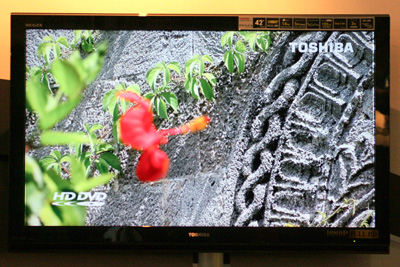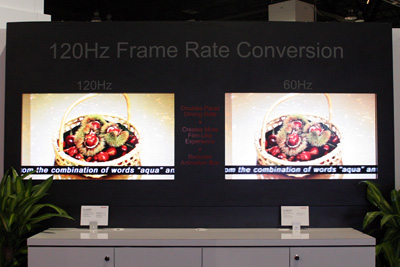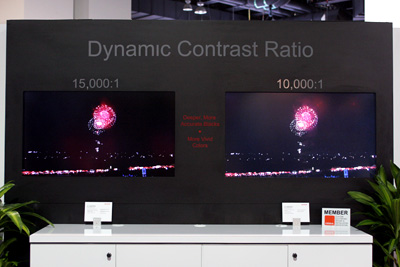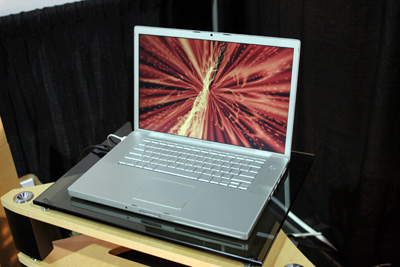I recently read an audio review in which the writer called
the subject "a no-brainer." However, it wasn’t clear to me whether it took
no brains to buy the product, or that you must have no brains if you bought it.
The product seemed rather silly.
On the other hand, there’s no question that you need
plenty of brainpower to buy a flat-panel display these days with all the options that are
available. For example, yesterday I described the conundrum I am in after the comparisons
at the Sharp booth. Today I went to see the Toshiba Regza Cinema Series displays and was
confronted with so much techno-marketing jargon that my head started to spin: "xvYCC
Expanded Color Support," "PixelPure 3G 14-Bit Internal Digital Video
Processing," "DynaLight Dynamic Back-Light Control," blah, blah, blah.
What does all this mean, and how the heck is the average consumer supposed to figure out
what to buy?

The Toshiba Regza 42LX177.
Audio equipment is so much easier to understand.
Even the most complex components are no-brainers compared to video displays.
***
I’m currently in the market for a flat-panel
display for my living room, and my heart has been set on a Sharp. So I was eager to drop
by Sharp’s CEDIA booth and see all the current panels on display -- in particular,
those that were 42" or smaller, because anything larger is too big for my room.
I was quite impressed with Sharp's demonstrations comparing
62-series displays to the more-expensive 92-series models. One demo showed the superiority
of…

…the 92s' 120Hz frame-rate conversion (versus 60Hz for
the 62s), which results in less digital jiggles during fast-moving scenes (a 92 on the
left, 62 on the right). The other demo showed…

…how much better the blacks were on the 92-series
displays due to their improved contrast ratio: 15,000:1 "Dynamic Contrast Ratio"
for the 92 displays versus 10,000:1 for the 62 models.
These comparisons were so telling that I decided then and
there that I couldn’t live with a 62-series display. I needed a 92. However,
I then learned that the smallest 92-series display is 46" – larger than I can
accommodate in my room.
So now what am I supposed to do? Sharp’s demos
were quite convincing, letting me know that the 62s basically look like crap compared to
the 92s; however, now that I’m aware of that, I then find out that I can’t get a
92 in the size I need. Do I buy an inferior-looking 62-series display knowing full well
that the larger 92 models look so much better? Or do I forget about Sharp displays and
look more seriously at other company’s models? I’m up in the air.
The moral of this long story? Sometimes comparison demos
can help sell a product, but other times they might chase potential customers away.
***
Ever since I reviewed MSB's
iLink, CD transports, hard drives, and high-resolution digital formats have been on my
mind. So when I visited the Naim display and saw an
iBook used to stream music files to the Super Nait integrated amp, which has a
built-in DAC, I knew I had my topic for today. In my opinion, SACD and DVD-Audio are as
close to dead as any format can be without the sheet being pulled over it. Just look
around CEDIA -- you'll find just a few new SACD players and no new DVD-Audio players.

But this paucity of new SACD and DVD-A players
doesn't matter. The next step in high-resolution audio is already here -- and has been for
25 years. I believe the CD is good enough to satisfy the most discriminating listeners
and, believe it or not, it will get even better as people abandon transports and use their
computer hard drives to stream CD-ripped files.
The MSB iLink demonstrated to me that
bit-perfect CD-ripped files streamed from a hard drive sound better than the same CD
played on a conventional CD transport. Whether it's due to the CD transport's read errors
or jitter or something else, I'm not sure. But what I do know is that the same files
streamed from a computer-based source sounded better when fed to the same DAC, and I
believe that's where the future of digital audio lies. Most people still haven't heard
just how good CD sounds, and it'll only get better.

